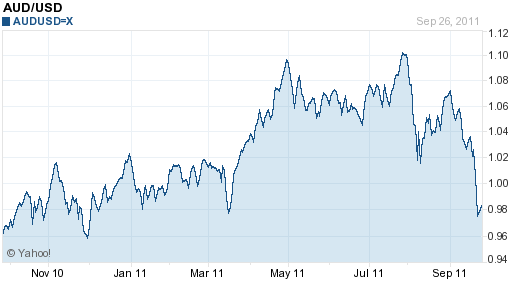The Australian dollars love affair with gold is about as public as they get. Over the past two years they have experienced the most extraordinary rise, hand-in-hand as the hysterical demand for gold pushed it to $1900 levels. Australian mineral wealth has always been central to the country’s economic expansion but the unprecedented boom that both the gold rush from crisis-battered investors in the west and the insatiable demand for commodities from the likes of China have sent the currency into orbit since 2009. Indeed, with the powers of hindsight, if you had been shrewd enough to have bought the currency on the 2nd March 2009 and forgotten about it until today you would be sitting on over 3500 points with zero drawdown.

Australia has certainly been the winner, if only economically, during the debt, disaster and double-dips that the majority of nations are hearing of every day. Even regional catastrophes, earthquakes, tsunamis and near-nuclear-meltdown in the Pacific region haven’t stifled the resolve of the AUD to keep rising. Whilst the rest of the world has been chopping their interest rates to almost Japanese levels, Australia has experienced high interest rates of 4.75% and growth of over 2.7%. This year they are expected to surpass this. The major problem now appears to be tempering the economy rather than trying to revive it.
Despite this epic rise and demand for Australian dollars, from a technical perspective the currency is looking as if it may have hit a ceiling. Gold has started its decline from the unsustainable highs and at least needs to have a corrective breather for a sustained period. The rallying support for the Greek economy today from the Japanese has muted those calling for the Euro’s blood and has further eased the upward pressure on Gold. As a commodity driven economy, it is not always in its best interests to have sky-high currency values when your major sales assets are falling in price. This correction may come as something of a respite for Australian policy makers who had been looking to control inflation and prevent the Australian dollar from the bubble effect.
Looking at today’s value the Australian dollar against the USD is at a highly significant trading area for technical traders. It has made a steady move down over the past two months, and according to Elliot wave analysis it may be approaching its fourth wave down. Traders looking at key areas of support and resistance would point to the spike down and subsequent support between the 9th and 11th of August to offer considerable resistance to any upside movement. This could be a very significant test of whether the AUD is in for a more sustained move down. Further to this it is now testing the classic psychological level of the 1.0000 mark which, as today has proven, can often be tough to break back through. To add to this a move lower for the AUD would make sense fundamentally as well technically, even with the demand for riskier assets has been buoyed by the support for Greece, it is a correction that may have been on the cards for quite some time.
Comments (No)